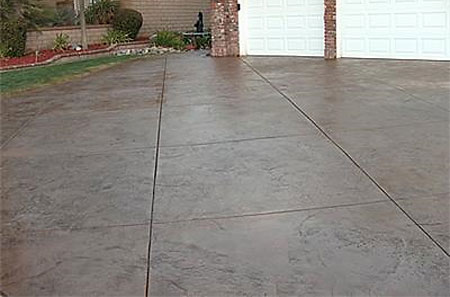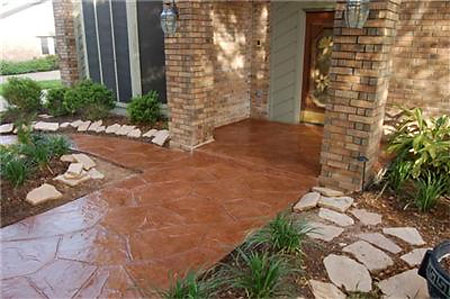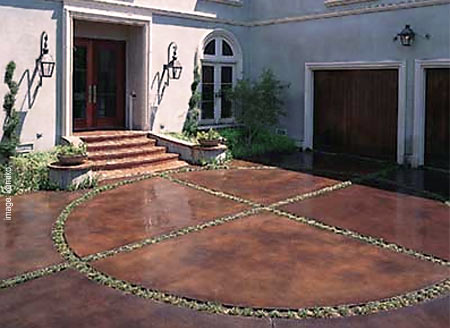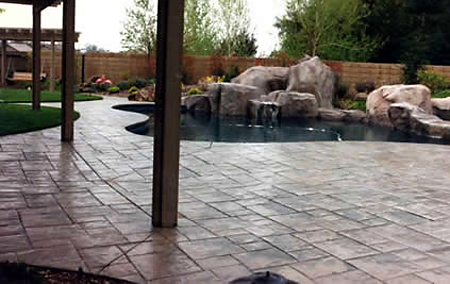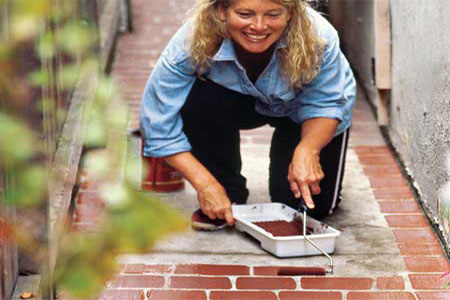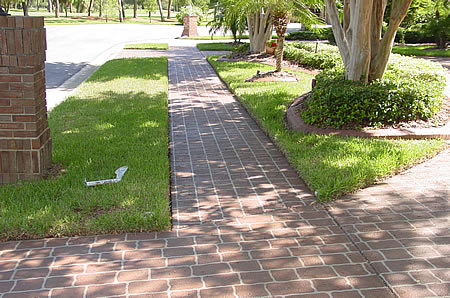Ideas for decorative concrete
There are many options available for transforming that drab concrete patio, driveway, or floor into a new, decorative, coloured concrete surface. Plus, you'll save money, conserve resources, and eliminate disposal problems.
09/07/2021
If your concrete is in good condition but just needs a facelift, you can stain, stencil, overlay or paint it to improve the appearance. Here is some advice on improving the look of your concrete flooring - indoors and outdoors.
Can concrete be fixed?
The underlying concrete for a resurfacing project must be sound. Where concrete is cracked all the way through or has sunk below the original level it is best to:
- Remove the concrete
- Remove the sub grade
- Replace sub grade with compactable material
- Compact the sub grade
- Pour back concrete
Concrete that is cracked only on the surface, or very thin cracks where each side of the crack is still level (there is no settlement) - can be successfully repaired - see www.cnci.org.za/inf/leaflets_html/repair.html.
How to clean concrete
Although water alone can remove dirt from concrete, cleaning chemicals often are needed to remove specific stains. Many contractors and concrete resurfacing companies in Tampa FL, recommend spraying the stain with the recommended chemical and letting it sit for about 15 minutes before power-washing the area.
For stained concrete, in addition to hot water, an alkaline degreaser will greatly increase removal rates of oil and grease. Hot water lifts the oil from the concrete, and the degreaser emulsifies the oil, allowing it to be flushed from the surface.
Heavy rust stains can penetrate deeply into concrete, so they can be tough to remove completely. Cleaners containing oxalic acid are most effective.
Graffiti can be very difficult to remove, depending on the type of paint used. Several proprietary graffiti strippers are available, many of which contain a citrus-based solvent, methylene chloride, or potassium hydroxide. Citrus-based solvents are the least aggressive and may not work on certain paints, but they are the safest to use.
Make a poultice to remove stubborn oil stains: a poultice is made by saturating an absorptive material (such as kitty litter, pool filter media, or sawdust) with a strong solvent (acetone or lacquer thinner will work) and then smearing the material over the stain. Cover the poultice with plastic, and let the process of osmosis take over. The solvent will break down the oil, and the absorptive material will suck it out of the concrete. However, this process takes time and may not be cost-effective or practical for removing large stains.
Sealing concrete
To seal concrete - after it has completely cured - you can used a sealer that is specially and uniquely formulated to seal concrete. Paving Sealer is a penetrating waterbased sealer that uses the best properties of silicones and acrylics to protect the surface from most stains. The sealer penetrates and therefore maintains the anti-slip and natural properties of the surface.
All concrete sealers should be applied to concrete that is clean and dry. All stains, grease, oil, dust, and dirt should be removed prior to application of the sealer.
Roll on faux bricks
Replacing an old concrete path with natural stone or cast pavers is always a good way to go, but it can also require loads of cash. So instead of repaving, give your walkway a face-lift with paint. Sweep the surface, let dry and then, starting in one corner, use a small foam roller to create a "brick" with a terracotta-hued floor paint. Paint another one below it, and so on, to make a border; repeat along the other side. Fill the space in between with a running bond pattern of bricks. Don't worry about keeping them exactly the same size or the lines pin-straight; imperfections make the design realistic.
Bear in mind when painting exterior areas that receive heavy foot traffic, the paint often wears away and the area will need repainting.
Fresh concrete should never be painted. Allow the concrete to cure for at least 28 days before painting.
janice anderssen - time inc - concrete network

